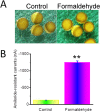Formaldehyde impairs transepithelial sodium transport
- PMID: 27762337
- PMCID: PMC5071906
- DOI: 10.1038/srep35857
Formaldehyde impairs transepithelial sodium transport
Abstract
Unsaturated oxidative formaldehyde is a noxious aldehyde in cigarette smoke that causes edematous acute lung injury. However, the mechanistic effects of formaldehyde on lung fluid transport are still poorly understood. We examined how formaldehyde regulates human epithelial sodium channels (ENaC) in H441 and expressed in Xenopus oocytes and exposed mice in vivo. Our results showed that formaldehyde reduced mouse transalveolar fluid clearance in vivo. Formaldehyde caused a dose-dependent inhibition of amiloride-sensitive short-circuit Na+ currents in H441 monolayers and of αβγ-ENaC channel activity in oocytes. α-ENaC protein was reduced, whereas phosphorylation of the extracellular regulated protein kinases 1 and 2 (ERK1/2) increased significantly post exposure. Moreover, both α- and γ-ENaC transcripts were down-regulated. Reactive oxygen species (ROS) was elevated significantly by formaldehyde in addition to markedly augmented membrane permeability of oocytes. These data suggest that formaldehyde contributes to edematous acute lung injury by reducing transalveolar Na+ transport, through decreased ENaC activity and enhanced membrane depolarization, and by elevating ROS production over long-term exposure.
Figures









Similar articles
-
Lipopolysaccharide modifies amiloride-sensitive Na+ transport processes across human airway cells: role of mitogen-activated protein kinases ERK 1/2 and 5.Pflugers Arch. 2010 Feb;459(3):451-63. doi: 10.1007/s00424-009-0717-4. Epub 2009 Oct 13. Pflugers Arch. 2010. PMID: 19823867 Free PMC article.
-
Expression and regulation of epithelial Na+ channels by nucleotides in pleural mesothelial cells.Am J Respir Cell Mol Biol. 2009 May;40(5):543-54. doi: 10.1165/rcmb.2008-0166OC. Epub 2008 Oct 16. Am J Respir Cell Mol Biol. 2009. PMID: 18927349 Free PMC article.
-
Regulation of alveolar epithelial Na+ channels by ERK1/2 in chlorine-breathing mice.Am J Respir Cell Mol Biol. 2012 Mar;46(3):342-54. doi: 10.1165/rcmb.2011-0309OC. Epub 2011 Oct 13. Am J Respir Cell Mol Biol. 2012. PMID: 21997487 Free PMC article.
-
Alpha(1)-antitrypsin inhibits epithelial Na+ transport in vitro and in vivo.Am J Respir Cell Mol Biol. 2009 Sep;41(3):261-70. doi: 10.1165/rcmb.2008-0384OC. Epub 2009 Jan 8. Am J Respir Cell Mol Biol. 2009. PMID: 19131639 Free PMC article.
-
AICAR decreases the activity of two distinct amiloride-sensitive Na+-permeable channels in H441 human lung epithelial cell monolayers.Am J Physiol Lung Cell Mol Physiol. 2008 Nov;295(5):L837-48. doi: 10.1152/ajplung.90353.2008. Epub 2008 Aug 22. Am J Physiol Lung Cell Mol Physiol. 2008. PMID: 18723760 Free PMC article.
Cited by
-
Short Term Exposure of Sheep Tracheal Epithelium to Cigarette Smoke Extract Reduces ENaC Current: A Pilot Study.In Vivo. 2024 Sep-Oct;38(5):2294-2299. doi: 10.21873/invivo.13694. In Vivo. 2024. PMID: 39187341 Free PMC article.
-
Metabolic regulation adapting to high methanol environment in the methylotrophic yeast Ogataea methanolica.Microb Biotechnol. 2021 Jul;14(4):1512-1524. doi: 10.1111/1751-7915.13811. Epub 2021 May 3. Microb Biotechnol. 2021. PMID: 33939325 Free PMC article.
-
Evaluation of chemical constituents and in vitro antimicrobial, antioxidant and cytotoxicity potential of rhizome of Astilbe rivularis (Bodho-okhati), an indigenous medicinal plant from Eastern Himalayan region of India.BMC Complement Altern Med. 2019 Aug 5;19(1):200. doi: 10.1186/s12906-019-2621-6. BMC Complement Altern Med. 2019. PMID: 31382946 Free PMC article.
-
Novel mechanisms for crotonaldehyde-induced lung edema.Oncotarget. 2017 May 12;8(48):83509-83522. doi: 10.18632/oncotarget.17840. eCollection 2017 Oct 13. Oncotarget. 2017. PMID: 29137360 Free PMC article.
-
Bone marrow mesenchymal stem cell-conditioned medium facilitates fluid resolution via miR-214-activating epithelial sodium channels.MedComm (2020). 2020 Nov 12;1(3):376-385. doi: 10.1002/mco2.40. eCollection 2020 Dec. MedComm (2020). 2020. PMID: 34766129 Free PMC article.
References
-
- Stedman R. L. The chemical composition of tobacco and tobacco smoke. Chem Rev 68, 153–207 (1968). - PubMed
-
- Shin H. J. et al.. Effect of cigarette filters on the chemical composition and in vitro biological activity of cigarette mainstream smoke. Food Chem Toxicol 47, 192–197 (2009). - PubMed
-
- Nikota J. K. & Stampfli M. R. Cigarette smoke-induced inflammation and respiratory host defense: Insights from animal models. Pulm Pharmacol Ther 25, 257–262 (2012). - PubMed
-
- Moretto N., Volpi G., Pastore F. & Facchinetti F. Acrolein effects in pulmonary cells: relevance to chronic obstructive pulmonary disease. Ann N Y Acad Sci 1259, 39–46 (2012). - PubMed
-
- Sangodkar J., Katz S., Melville H. & Narla G. Lung adenocarcinoma: lessons in translation from bench to bedside. Mt Sinai J Med 77, 597–605 (2010). - PubMed
Publication types
MeSH terms
Substances
Grants and funding
LinkOut - more resources
Full Text Sources
Other Literature Sources
Molecular Biology Databases
Miscellaneous

